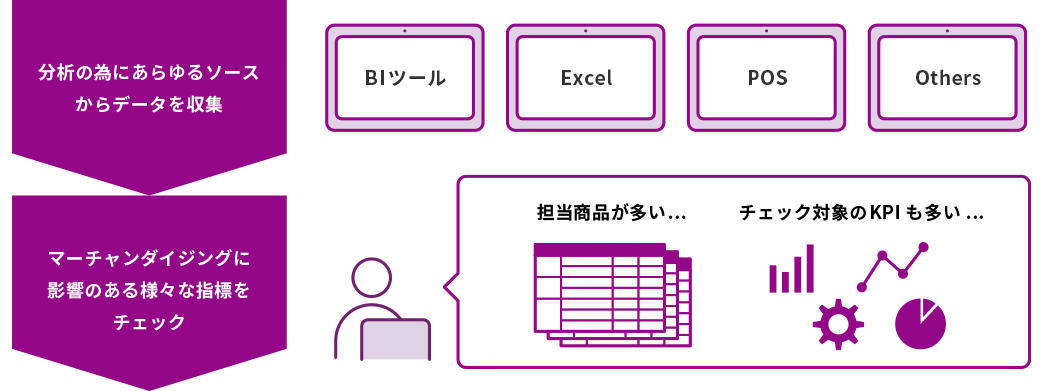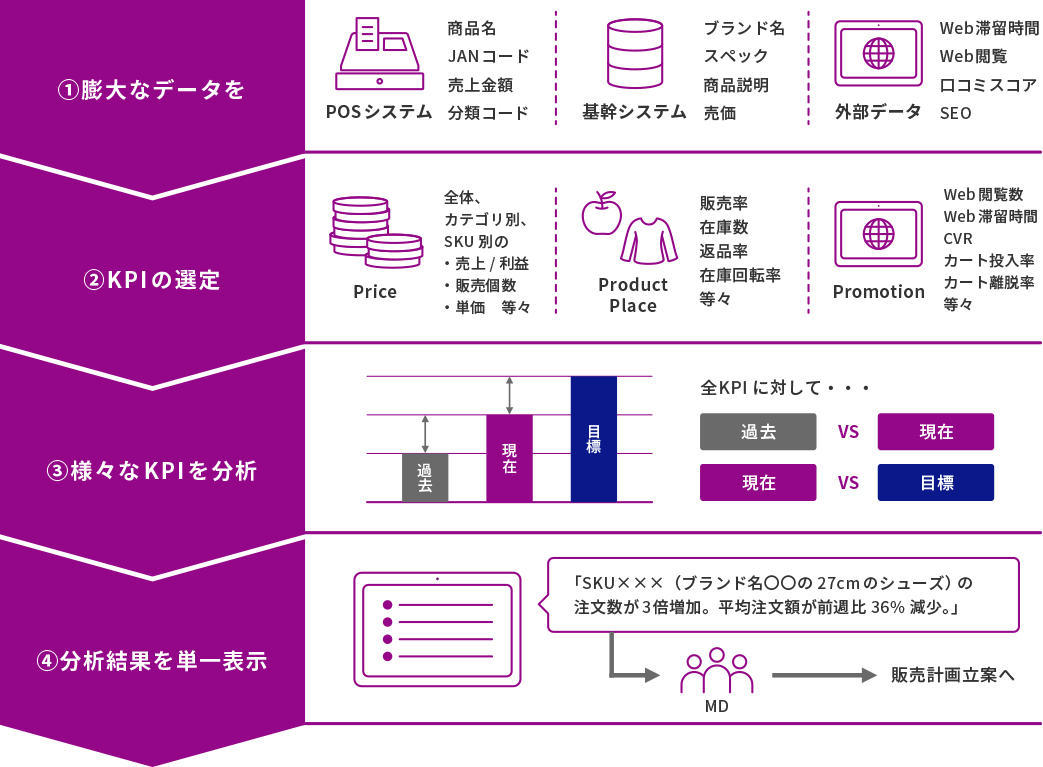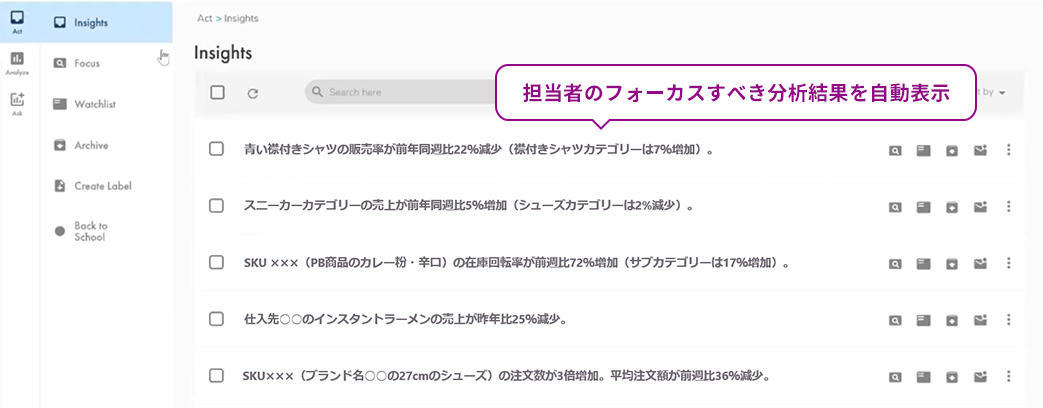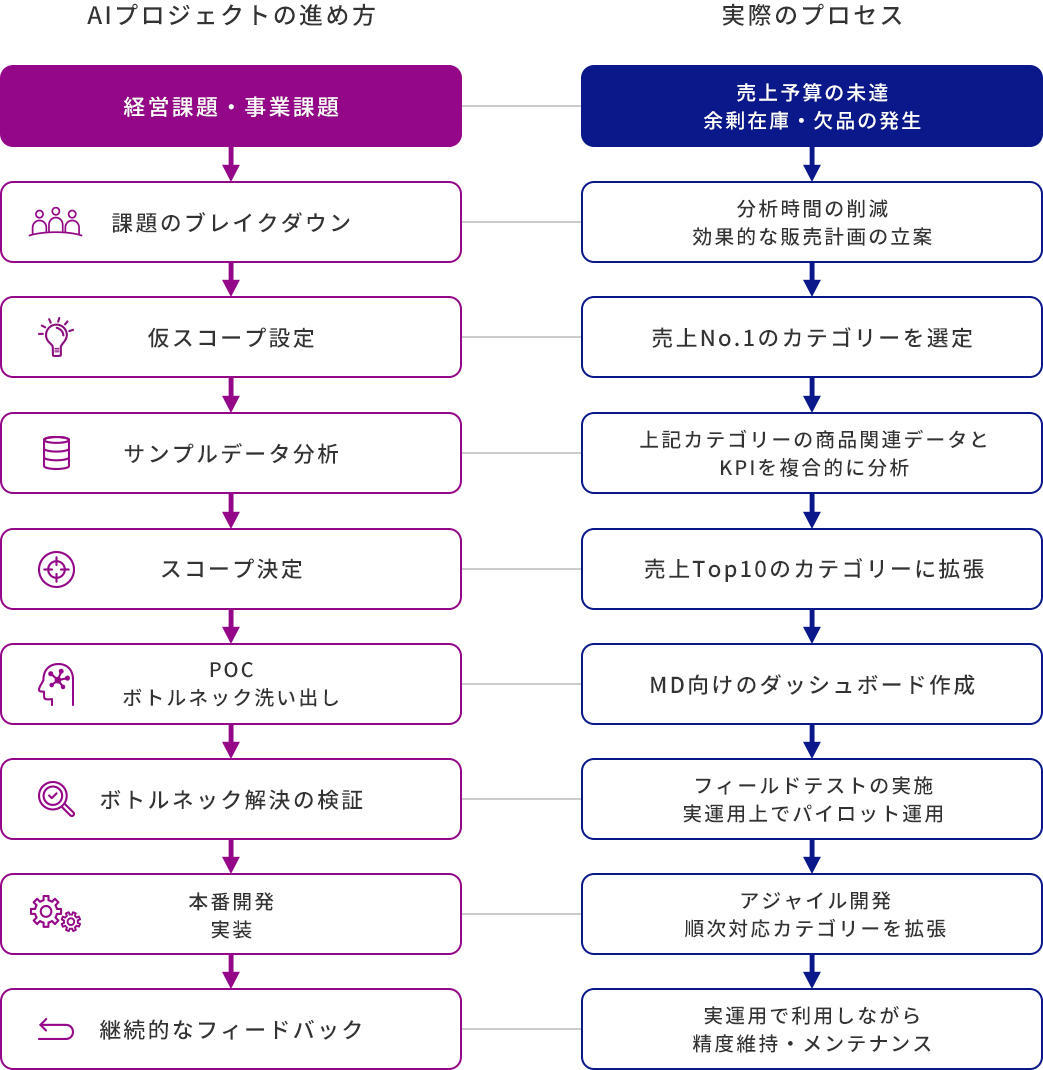Merchandising analysis and sales plan optimization
- Enables merchandising analysis with granularity and comprehensiveness that cannot normally be performed by “humans”
- Enables rapid formulation of effective sales plans that lead to increased sales
- Merchandising
- sales plan
- Product analysis
- BI tools
- CrowdANALYTIX
Business challenge
Merchandise managers and merchandisers (MDs) need to regularly consider and implement sales plans in order to achieve sales targets. A sales plan cannot be formulated without a comprehensive analysis that considers external factors in addition to overall product-related data such as sales, inventory, and sales promotions.
However, there is a limit to tracking related data and KPIs for all products by human power. Utilizing the characteristics of AI that can process large amounts of complex information, we aim to analyze huge amounts of merchandising-related data and enable MDs to quickly formulate effective sales plans.
Task
In the retail, distribution, and apparel industries, product managers and MDs are responsible for providing the right products and services for customers, at the right price, in the right quantity, at the right time, at the right place, in order to achieve their sales targets. We aim to sell (five aptitudes), and for that reason, we regularly formulate a sales plan as there is a word 52 weeks MD. The frequency varies depending on the person in charge and the product, but in the case of 52-week MD, it is said that it is necessary to analyze the sales results every week, make future forecasts, and revise the plan according to the forecasts. there is
If you follow this cycle and keep making accurate forecasts, you can achieve the five aptitudes mentioned earlier and achieve your sales targets, but what is the reality? Despite conducting weekly analysis, making predictions, and working according to the planned plan, "trends were lost and surplus inventory appeared" and "opportunity losses occurred due to shortages". Isn't there a result like this?
A major retailer in the United States (hereinafter referred to as Company A), which sells a large number of products in stores and through e-commerce, assigns an MD to each product category. In addition, each MD formulates a sales plan while utilizing multiple analysis tools such as BI tools on a weekly basis in order to achieve the budget that can be set for each quarter, but even so, there are surplus inventory and shortages. Outing was happening in each category.
Why are results not accompanied by regular analysis, forecasting, planning and execution of sales plans? As a result of reviewing its operations, Company A identified the following issues in the analysis stage, which is the first step in formulating a sales plan.
- ✔ You waste a lot of time checking various reports and dashboards every Monday. (At Company A, analysis and planning took six hours per MD per week.)
- ✔ There are too many products and KPIs to be checked, and the sales plan is being drafted without clarifying the actions that should be prioritized based on the analysis results.
While the number of actions that can be taken in a week is limited, we thought that misjudgement of the actions to be taken would lead to excess inventory and shortages, which would be a hindrance to sales expansion.

Problem-solving process
Therefore, Company A aimed to create a system to support the formulation of effective sales plans that lead to reductions in merchandising analysis time and results. The ideal operation is, ``If you check one dashboard when you come to work every Monday, you can immediately grasp the events that have a large impact on budget achievement among the transactions of the category you are in charge and the products that occurred last week.'' Thing. For that reason, it is necessary to build a platform that analyzes a huge amount of product-related data from the past to the present from various KPIs. Ultimately, we plan to implement this analysis platform in all categories, but first we decided to set the scope for the No. 1 sales category, which has a large impact.
The first step was to pull all the data from the last few years related to the products in the category into the platform. It collected data from various sources, including POS systems, product masters, customer portals, and products posted on EC, including EC-related traffic.
The next step is the phase of choosing what KPIs should be tracked against the ingested data. Not only sales, profit, and quantity, but also sales rate, inventory turnover rate, number of web browsing, cart insertion rate, etc. was selected. This completes the platform preparation stage.
In the analysis stage, a large amount of product-related data from the past to the present was comprehensively analyzed from various selected KPIs, and compared with "last week's results vs. past results and target figures." As a result of the comparative analysis, we were able to detect past trends and results that deviate from the target figures as events that should be considered in particular.
Based on the detection results, Company A determined that the MD could immediately formulate a sales plan, expanded the scope to the top 10 sales categories, and created a demo that displayed the detection results on a single dashboard. did. MDs in the target category are freed from the analysis time they used to spend, and are now able to quickly formulate sales plans based on the events listed on a single dashboard when they arrive at work every Monday. By tracking data ranges and KPIs that were previously uncovered, it is now possible to formulate more accurate and effective sales plans. Analyzing the vast amount of data that is generated every day, including the past, and continuing to track it with various KPIs is a feat that "humans" cannot do.
Company A is currently increasing the categories it analyzes. Even if the number of products handled increases in the future for business expansion, this analysis platform will support the rapid formulation of effective sales plans for any MD.

analysis


